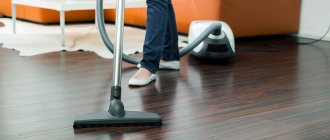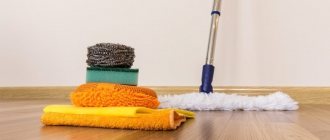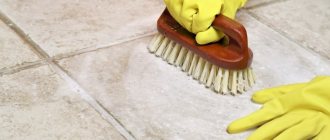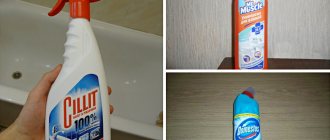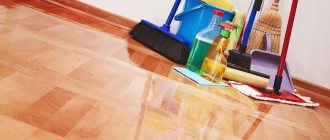The long-awaited, but still bringing a lot of trouble and inconvenience, repairs are behind us. All that’s left is to remove the construction waste and thoroughly wash the floor. And here the problem arises of how to clean the floor after renovation, because whitewashing, painting, plaster, and just construction dust do not respond to every detergent. In this review you will find answers to all the questions that arise in the process of cleaning floors, tips that will greatly facilitate the work and help achieve an impeccable result.
How to clean floor tiles after renovation
Method 1
The following homemade bleaching agent will whiten the seams between the tiles, and also refresh the tiles themselves:
- Prepare 10 cups of water in a deep enough container, as the mixture may react and rise for a while;
- Add ½ cup of soda and 1/3 cup of lemon juice to it;
- Pour in ¼ cup vinegar;
- Mix, put on gloves and wash the tile floor with the solution.
Method 2
Ideally washes tiles after repair from dust, dirt, glue, as well as those contaminated over time with Stork Sanox gel.
- Put on gloves, apply the gel to the sponge, and then to the tile;
- The action of the product is immediate, so you can wash it off almost immediately with clean water and enjoy the result.
Method 3
It will not be difficult to wash off construction dust from the tiles. Water with lemon or vinegar, glass cleaner, and even ordinary soapy water will perfectly clean and add shine. But the adhesive solution, especially a dried one, is more difficult to deal with. First you need to soften it.
- Moisten the adhesive stains on the tiles with a mixture of water and vinegar, or water and ammonia (you can also use acetone, after testing it on a small area to avoid the risk of damaging the tiles);
- The softened glue can be scraped off with a stiff sponge or scraper.
Method 4
The hardened primer can be washed off with acetone, or you can purchase a special remover that includes a solvent. The principle of operation is similar to the previous option.
- Apply solvent or acetone to the primer stains;
- Once they have softened, remove them with a glass scraper.
Method 5
You can get rid of acrylic primer from tiles in this way:
- Wet a towel and place it on the stained surface;
- Keep it moist for several hours by sprinkling with water;
- Once the soil has swelled, it can be gently cleaned with Pemolux and rinsed off with clean water.
Method 6
Paint stains on tiles can be easily removed with products such as Mole, Pufas Abbeizer or regular acetone. As an option - liquid glass. When it turns into a film, it is easy to peel off along with the paint.
Method 7
Cement residues on tiles can be removed using Atlas Szop, Milizid, or an effective mixture of vinegar, citric acid and Domestos.
It is much easier to remove any contamination immediately after it gets on the tiles, before it hardens.
Method 8
If you don't know how to clean grout from tile floors, experiment with the following methods and products, keeping in mind that smooth glazed tiles can be cleaned well with a dry cloth, followed by water and detergent. Matte glazed – with an acid-containing substance.
- A mixture of oxalic acid and water washes the grout;
- Table vinegar, can be diluted with water;
- Acid-containing substances will help, for example, “Deterdek”, “Litoclean”;
- Cleaning product "Cinderella";
- You should try gasoline, acetone, and white spirit.
Parquet cleaning
Before you wash the parquet after repair, you must first find out what type of contamination you are dealing with - the method of cleaning the surface will depend on this.
Common water-soluble dirt (putty, whitewash) can be removed with plain water and a small amount of detergent. That is why special preparation and long thoughts about how to wash putty from the floor are not required. In addition, the use of water to wash away dirt in the case of parquet is also justified for the reason that parquet is not afraid of moisture and is excellent for wet cleaning.
It will be much more difficult to deal with paint or glue that gets on the parquet.
Here you will have to use the following recommendations:
- Solvents are used to remove serious stains, but it is necessary to act with extreme caution: solvents can damage the top layer of parquet and thereby render it unusable;
- It is best to use soft compounds - white spirit, kerosene, methyl alcohol or substances for caring for stoves;
- To wash off dirt, a small amount of solvent is applied to the dirt and rubbed, and the sooner this is done, the easier it will be to remove the stain;
- Before eliminating contaminants, it is better to test how the solvent will act on a small, inconspicuous area of the coating.
We recommend: Water-heated floor under laminate
In addition to methods for washing dirt on parquet, you need to know what methods of exposure to this floor covering are prohibited:
- Parquet cannot be cleaned using rough brushes and metal scrapers: these devices can damage the varnish layer, thereby completely ruining the coating;
- When wet cleaning, you need to monitor the amount of water used: parquet can be washed, but an excessive amount of water can render it unusable;
- Detergents containing abrasive particles or aggressive solvents cannot be used to wash parquet flooring - its surface is not designed to withstand such loads.
How to remove whitewash from the floor after renovation
Before whitewashing, the floor must be covered with plastic film. But, if the floor is already dirty, there is no reason to be sad, since there are many ways to clean the floor after repair, in particular whitewashing, taking into account the degree of its contamination.
Method 1
The most popular, easy and affordable option.
- Fill a suitable container with water and add vegetable oil to it (100 g of oil per 10 liters of water);
- Wash the floor with this mixture, pour out the water;
- Fill the container again with clean water and pour 1 tbsp into it. vinegar;
- Rinse the floor with this mixture;
- Finally, wash the floor thoroughly with clean water.
Method 2
It’s even easier to use any dishwashing detergent to remove whitewash.
- Dilute dish soap in water and wash the floor;
- If necessary, repeat the procedure several more times.
Method 3
The method is effective, but it won’t be limited to one-time washing; it will take 3-4 or even more times.
- Dilute vinegar in water (200 ml of vinegar per 10 liters of water);
- Wash the floor thoroughly;
- Change the water and rag and wash again to the desired result.
Method 4
- Wash the floor with clean water;
- Take clean water again and dissolve table salt in it (5 tablespoons of salt per 10 liters of water);
- Wipe the floor with salt solution;
- Change the water, add vinegar to it (200 ml of vinegar per 10 liters of water), wash the floor;
- The product will rid the floor of whitewash.
How to clean plaster from a floor after renovation
As a rule, gypsum plaster is most often used, followed by cement. Gypsum plaster hardens quickly, so it should be washed off the floor as soon as possible. In fact, gypsum is chalk, so all of the above methods of washing whitewash from the floor will help. Chemical agents are also effective, for example, “Atlas Szop”, “Plitonit wash”. Additionally, try removing gypsum plaster using the following method:
- Remove large pieces of plaster with a wooden or plastic spatula;
- Clean the floor with a dry cloth;
- Dampen the cloth and place it over the plaster stains;
- When the plaster gets wet, it can be washed with vinegar or oil, as is the case with floors after whitewashing.
Cement plaster is removed in the following ways:
- Pour acetic acid onto the cement stains;
- 5-10 minutes after it dissolves, wipe off the residue with a dry cloth.
Concrete cleaners and solvents will also help: “Lepta Himfrez”, “Lugato Zementschleierentferner”, “Bio Decap' Beton Guard”.
Important: Always read the instructions for use of chemicals carefully. Their safety does not apply to all types of floor coverings.
Methods of cleansing
To remove putty residues, you can use several methods. Each of them has its own technological process. The cleaning option depends on the type of coating.
Mechanical wash
The method is simple and does not require any special knowledge or skills.
The main disadvantage is labor intensity. Used: Manual work will take a lot of time. Mechanical processing is permissible for uneven structures:
Chemicals
The chemical removal method involves wetting the surface with the selected solution.
How to clean linoleum after repair
The vast majority of tips presented on how to clean a floor after renovation, depending on what exactly it was contaminated with, are effective in this matter. But, in the case of linoleum, it is important to consider the following points:
- Do not use soda, alkali and other abrasive substances so as not to scratch the coating or make it brittle;
- Do not wash linoleum with too hot water;
- When cleaning linoleum, avoid using alcohol, including ammonia;
- Apply gasoline, turpentine, kerosene only to stains, or better yet;
- Always test even the most vaunted product on a small and inconspicuous area of linoleum. Otherwise, there is a risk that the design will be washed off and the coating will become rough.
Expert advice
Thoughts about cleaning after renovation appear at a stage when it has not even begun. Simple expert advice will help make the whole process easier:
It is possible to remove the remnants of the putty layer in various ways - with ready-made or improvised means. The choice depends on the material contaminated with the building mixture.
Source
How to clean laminate floors after renovation
Laminate flooring today occupies a leading position. This is a beautiful, durable and expensive coating, so it’s difficult to resist noticing that before repair work it is very important to take proper care of it and protect it from contamination. But, if a mistake has already occurred, the following tips will help eliminate the problem.
Method 1
If the laminate is stained with paint, alcohol, white spirit or acetone will help to remove it:
- Remove large debris, vacuum small debris;
- Apply the product to a cotton swab and treat the stain;
- Wipe the treatment area with a damp cloth.
Important: laminate floors are washed with a minimum amount of water. After washing, wipe dry to avoid swelling and deformation of the joints.
Method 2
Dirt and dust are easily washed off with dishwashing detergent added to water. You only need to use soap suds or wring out the rag as thoroughly as possible. If there are stains, you can wash the floor with water with vinegar added to it (for 10 liters of water - 1 glass of vinegar).
Method 3
Splashes of whitewash on a laminate floor can be removed with window cleaner, after which the floor is wiped with a soft cloth. Also effective in this case are vegetable oil, salted water and a vinegar solution.
Method 4
The laminate stained with polyurethane foam will be washed off with the medicine Dimexide. The drug should be used in a ventilated area due to its strong odor.
- Soak a cotton swab in the product and place it exclusively on the stain;
- Leave on for 10 minutes and rinse off.
Method 5
Purchased products specifically designed for laminate care will also help restore a beautiful appearance and remove stains. These are “Pronto for cleaning wooden floors”, “Mellerud BIO”, “Emsal Laminate”, “Mr.Proper”.
Use the same products and recommendations to clean parquet floors after repairs.
First stage: cleaning construction dust
The simplest option for cleaning a room from dust may seem to be a household vacuum cleaner. But this will be the wrong decision. Your home vacuum cleaner will quickly become clogged with tiny particles, causing the motor to burn out. To clean premises after renovation work, it is better to use a construction vacuum cleaner. If you don’t have one, you can use a household one, but only after thoroughly wetting the floor.
You need to take a spray bottle and spray water around the room. As the liquid settles, it moistens the dust particles and forms a crust on the floor. After this, you will need to wait for the crust to dry and collect the dirt with a vacuum cleaner.
How to clean a varnished floor after renovation
How to clean a floor after renovation if the coating is varnished? Try the following processing options.
- Oil paints on the floor are treated with white spirit. The main thing is to apply the product directly to the stain. After treatment, the floor is thoroughly washed and wiped with a damp cloth soaked in a solution of 10 parts water and 1 part glycerin;
- A mixture of 5 liters of water and ½ cup of salt will help remove whitewash or plaster. The composition cleans the floor well without leaving marks or streaks;
- Also, the varnished floor is washed with a mixture of 5 liters of water, 0.5 tsp. potassium permanganate and 1 tbsp. vegetable oil.
- Special cleaners for varnish coatings are used: “Bona Wood Floor Cleaner”, “IRSA Aqua Star R9”.
Disinfect and wash with potassium permanganate
This method is suitable for removing traces of whitewash from walls, baseboards, ceramic tiles, and dark linoleum. Categorically not suitable for light-colored floors: potassium permanganate will color them dirty brown. You should not try the method on varnished surfaces, as strong stains will remain.
Cleaning procedure:
- Add potassium permanganate powder little by little into a bucket of warm water and stir thoroughly. You should get a bright crimson color.
- They wipe the floor.
- They pass through with clean water, removing any remaining whitewash and permanganate.
How to clean floors after renovation without streaks
- Laundry soap will help eliminate stains on linoleum floors. A small amount of it is added to water, which should be changed very often, and the rag should be constantly rinsed and squeezed thoroughly;
- Laminate floors are washed with warm water and vinegar. The acid evaporates moisture, so there are no streaks left on the washed floor;
- Marble floors are not washed with soap or powder; it is best to use only warm water, adding a product with a neutral pH, for example, InterChem 501.
- When washing a tiled floor, ammonia, citric acid, vinegar essence, and window cleaner are added to the water.
- A mixture of water with the addition of a small amount of kerosene and table salt gets rid of stains on the floor.

